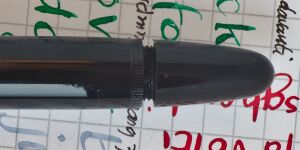Differenze tra le versioni di "Manopola/en"
| (Una versione intermedia di un altro utente non mostrate) | |||
| Riga 1: | Riga 1: | ||
| − | [[File:Columbus-65- | + | [[File:Columbus-65-Hooded-NoRing-Nera-Knob.jpg|thumb|A Columbus 65 ''knob'']] |
We should speak more specifically of a ''knob'' in all those cases in which the [[case back]] of a pen is not simply the end of the barrel, and is not used as a decorative element or as a [[blind cap]] for protection of the [[filling system]], but is instead a direct component of the latter, with the role of part of the device on which one must act to activate it. | We should speak more specifically of a ''knob'' in all those cases in which the [[case back]] of a pen is not simply the end of the barrel, and is not used as a decorative element or as a [[blind cap]] for protection of the [[filling system]], but is instead a direct component of the latter, with the role of part of the device on which one must act to activate it. | ||
Versione attuale delle 20:06, 23 dic 2024
We should speak more specifically of a knob in all those cases in which the case back of a pen is not simply the end of the barrel, and is not used as a decorative element or as a blind cap for protection of the filling system, but is instead a direct component of the latter, with the role of part of the device on which one must act to activate it.
Therefore, the bottoms of classic piston fillers are classifiable as such (not those used to protect a knob underneath), the knobs of plunger filler system, those of safeties and also those of some specific types of button fillers (like the push-knob). In all of these cases the knob is a constituent part of the pen's filling mechanism, and is used for handling. A photo gallery can be found on this page.
